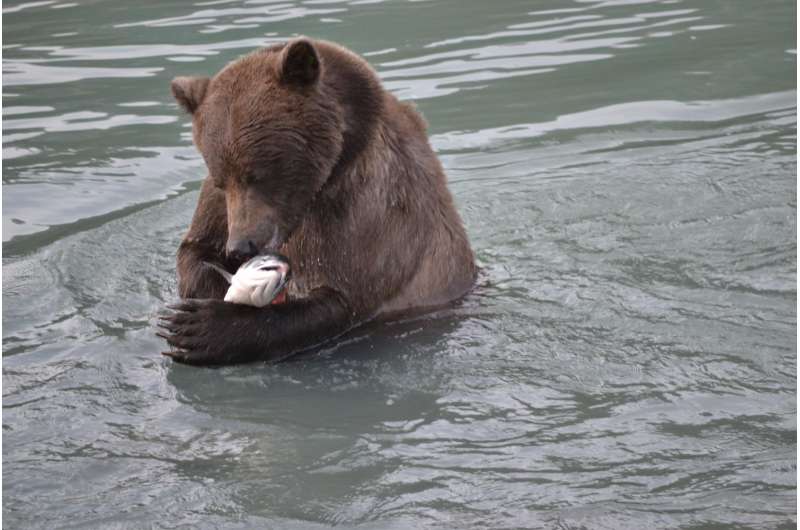The golden drool: Study finds treasure trove of info in saliva of foraging bears

The rivers and streams of Alaska are littered in the summer and fall with carcasses of tens of thousands of salmon that not only provide a smorgasbord for hungry brown bears but are also the newest database in the arsenal of wildlife biologists.
A new study, published this week in the journal PLOS ONE, documents the ability of researchers to gather DNA from residual saliva on partially consumed salmon to the point that they can even identify individual bears from the genetic samples. The discovery should provide a significant boost to research on the population and health of brown bears, which can grow to a size of 1,500 pounds.
"In the past, population estimates have been largely based on visual observations and on the analysis of fecal samples," said Taal Levi, an assistant professor of fisheries and wildlife at Oregon State University and co-author on the study. "We found that using bear saliva is not only easier and cheaper as a research tool, it is more effective."
In their study, the researchers examined 156 partially consumed salmon carcasses of lakeshore-spawning sockeye salmon in the Chilkoot watershed and stream-spawning chum salmon at Herman Creek in the Klehini watershed - both near Haines, Alaska. They also swabbed a total of 272 brown bear "scats," or fecal samples, from those same locations.
They found that the saliva collected from the salmon carcasses delivered a higher rate of genotyping success, allowing the researchers to identify individual bears more accurately and quickly than the fecal samples, and required significantly less labor.
"Bears love salmon because they are such a rich food source, and fortunately for us, the way they consume them lends itself to genetic monitoring," said the study's lead author, Rachel Wheat, who conducted the research as part of her doctoral dissertation at the University of California, Santa Cruz.
"When salmon are plentiful, bears rarely eat the entire fish. In some cases, they only eat the brain, and we've found that swabbing along the edges of the braincase gives us the best results for extracting DNA," Wheat said. "We also had success with swabbing inside distinct bite holes, and in the muscle tissue where the bears have stripped the skin off the salmon."
The researchers were able to get brown bear genotypes for 55 percent of all the salmon carcasses sampled for saliva, compared to 34 percent for the scat samples.
From a purely cost-savings perspective, the saliva sampling proved cheaper. It costs the researchers roughly $370 per bear to genetically identify individual animals using scat samples; the cost with saliva samples dropped to $118.
"This advance will help allow us to more effectively - and more economically - study one of the largest bears on the planet," Wheat said.
Levi agreed and also noted that the method does not have to be restricted to bear research. It could be adapted to other species, as well.
"Many predators leave saliva on food remains," he said. "We feel this type of saliva sampling could become an important tool for wildlife population monitoring."
Journal information: PLoS ONE
Provided by Oregon State University


















